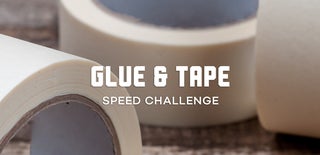Introduction: Clear Tape Models
Clear packing tape doesn’t seem like an exciting craft material, does it? It’s sticky, and you can see right through it. But.....some people make useful things, some people make scary things like ghosts, and some people make... art.
Mark Jenkins (http://www.xmarkjenkinsx.com/) covers people in tape, removes the shell, seals it, and creates urban art installations. You don’t have to cocoon your friends, though. I’m going to demonstrate the techniques on a smaller scale.
Step 1: Here's What You Need
Roll(s) of Clear Packing Tape—I used a roll of dollar-store, 2-inch-wide tape. You might need more for a larger project.
Plastic Wrap—The clingier the better. I had a 60-square-foot roll from a dollar store, and I didn’t use all of it.
Scissors—Some sets of instructions recommend a box cutter, but I feel more controlled with a pair of scissors.
Your model—I had planned to use a stuffed animal or a baby doll, but I didn’t have any available, and all the thrift stores I went to were trying to be Covid-19 safe, so there were no toys or dolls to be found, and I am too cheap to go out and buy something nice that I might accidentally mangle. I used a gorilla puppet that I own. Inanimate objects make good models: shoes, vases, trophies.
IF YOU USE A LIVE MODEL—A head-shaped wig stand—DO NOT WRAP A PERSON'S HEAD! Some people have used drinking straws or plastic tubing to keep the mouth and nose breathing passages open, but do you really want to risk losing a friend...or getting arrested?
Step 2: The First Layer - Plastic Wrap
Tape is sticky, and you do not want it to stick to a toy, doll, or helpless person. That’s why you should use plastic wrap as the first layer. Wrap the plastic around your model. I wrapped the puppet in sections, head, body, each arm and leg. The puppet has long arms and legs, but I wanted a more-natural anatomy, so I didn’t cover them with plastic wrap all the way to the shoulders and hips. Make sure that all parts of the model are covered, or tape will stick to the model, and there will be trouble removing the shell.
Step 3: The Tale of the Tape
Get that clear tape, and start wrapping. Cut small pieces of tape for detailed areas. If you are using a live model, wrap loosely. You do not want to cut off their circulation. Cover the model with at least three layers of tape to make a firm shell.
Step 4: A Brief Intermission
Rest for a while, because the next part needs steady nerves. Of course, if you are using a live model, you'd better keep the break short, because your victim is starting to feel like a fly in a spider's web!
Step 5: You're Such a Cut-Up!
Use the scissors to cut the tape shell free of your model. Slide the blade carefully under the tape and plastic wrap. Try to cut in a straight line, and make as few seams as possible. This is why I build the shell in sections, so I can have one cut per piece.
Step 6: Putting It All Together
This is the step where you seal the seams on each section, and seal the sections together. Bring the sides of your cut seams next to each other. Use small pieces of tape to cover the seam. If you can, put a few tape pieces on the inside of the shell to make it stronger. If you are able to pull out, cut out, or remove some of the plastic wrap, it makes the shell look even more ethereal.
Step 7: Now...What Will You Do?
Your shell is finished. What will you do with it?
- Put it on a shelf to look down at you?
- Stick it on your desk as a featherweight paperweight?
- Place it on a street corner, leaning up against a lamppost?
- Have it cling to the branch of a tree?
- Make it emerge from a wall?
Whatever you do, have fun!
Step 8: Bye-Bye...
...and don't forget to vote for this entry in the Tape and Glue Speed Challenge.
(Yes, that is my hand.)

Second Prize in the
Glue & Tape Speed Challenge











